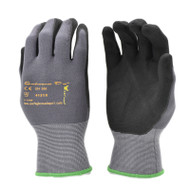Heat-Resistant Work Gloves – How to Pick the Best
Feb 24th 2023
Work gloves are crucial protective measures that are essential for workers' protection, whether they are used formally or at home. Due to this various gloves are available to address a range of risks, including abrasion, puncture, heat, and cold. One of the main requirements among them, which is met by a range of materials and designs, is protection from heat.
The following characteristics are primarily taken into account when looking for heat-resistant work gloves:
- Sturdiness
- Levels
- Size
The following are 5 factors to think about when selecting the best heat-resistant work gloves:
Requirement: Risk evaluation is crucial to choose the right kind of heat-resistant gloves. For instance, glassblowing demands dexterous gloves that cannot be provided because they are thick and heavy. What kind of work gloves you need depends on the sort of business you are in and the machinery you use. Important factors in this respect include dexterity vs. padding, the material choice and its inherent properties, and limitations.
Level: The most crucial stage in determining which glove is best for you is to gauge the heat of the object or contact surface from which you require protection. The most straightforward method to be precise is to use an infrared thermometer. This stage is crucial because if you underestimate the heat and wear thicker work gloves, you endanger your dexterity and movement and add unnecessary padding to your outfit. On the other hand, if you overestimate the heat, safety is put at risk.
Material: Many materials offer heat insulation, and each one has advantages and disadvantages. Rubber, leather, Kevlar, aluminum, and aramid are just a few of the components used. Again, each has advantages and disadvantages. For instance, synthetic materials like
Kevlar are an excellent choice for temperatures above 450°F. In addition to having great heat protection qualities, it also has abrasion and puncture resistance.
- Work Environment: The intensity of heat plays a role in deciding the glove's material composition.
- Dry versus Moist: It will aid you in choosing between a string-knit glove and a neoprene-dipped glove.
- Ambient versus Ambient: Do they protect from the room's temperature or do they have a clear contact surface?
- A flame or a spark: You need a substance that has been treated with a fire-retardant chemical when working with an open flame or spark.
- Other risks: No industry has a standardized set of risks, so having additional protective qualities—like Kevlar—in addition to heat protection wouldn't harm.
Above-wrist protection: The sort of work gloves you select should also take into account your wrists. Sleeves are not made to guard against heat, but rather an accidental contact. The use of para-aramid fibers is one example. Second-degree burns and minor discomfort are separated by this layer of defense. Therefore, one must not undervalue it.
At WorkGlovesDepot, we prioritize the utility and satisfaction of our customers above all else. We provide superior safety products for a variety of tasks. Our teams are committed to assuring both the safety of our customers and the ethical and responsible sourcing of our materials. If you want to purchase a large quantity of any kind of work gloves, including heat-resistant gloves, get in touch with us. Our gloves ensure that your employees' hands are completely safe.
